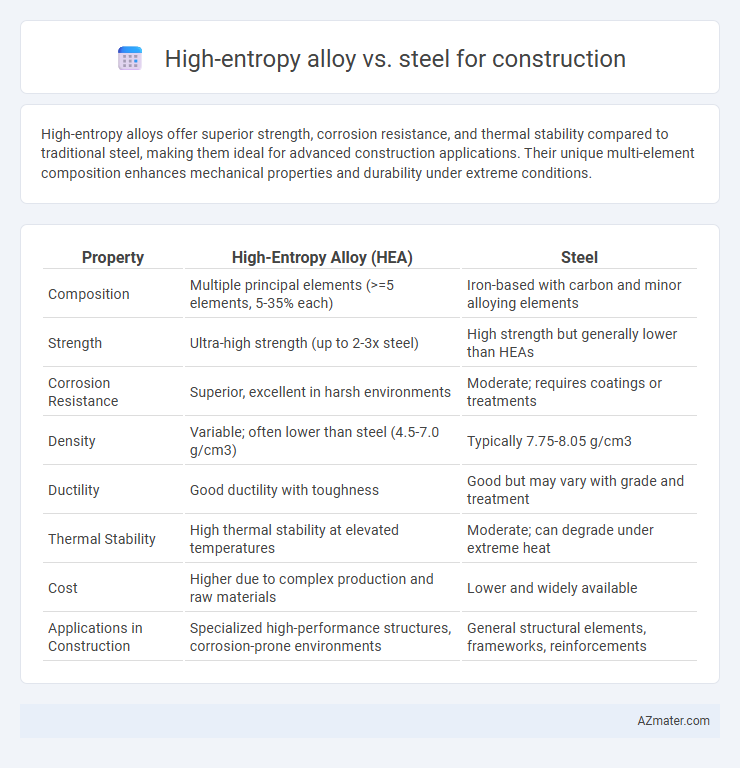High-entropy alloys offer superior strength, corrosion resistance, and thermal stability compared to traditional steel, making them ideal for advanced construction applications. Their unique multi-element composition enhances mechanical properties and durability under extreme conditions.
Table of Comparison
| Property | High-Entropy Alloy (HEA) | Steel |
|---|---|---|
| Composition | Multiple principal elements (>=5 elements, 5-35% each) | Iron-based with carbon and minor alloying elements |
| Strength | Ultra-high strength (up to 2-3x steel) | High strength but generally lower than HEAs |
| Corrosion Resistance | Superior, excellent in harsh environments | Moderate; requires coatings or treatments |
| Density | Variable; often lower than steel (4.5-7.0 g/cm3) | Typically 7.75-8.05 g/cm3 |
| Ductility | Good ductility with toughness | Good but may vary with grade and treatment |
| Thermal Stability | High thermal stability at elevated temperatures | Moderate; can degrade under extreme heat |
| Cost | Higher due to complex production and raw materials | Lower and widely available |
| Applications in Construction | Specialized high-performance structures, corrosion-prone environments | General structural elements, frameworks, reinforcements |
Introduction to High-Entropy Alloys and Steel
High-entropy alloys (HEAs) are advanced materials composed of five or more metallic elements in near-equal proportions, offering exceptional strength, corrosion resistance, and thermal stability. Steel, primarily an iron-carbon alloy, has long been the standard in construction due to its high tensile strength, ductility, and cost-effectiveness. Comparing HEAs and steel reveals potential advantages in structural applications, where HEAs provide superior mechanical properties and durability under extreme conditions.
Material Composition and Structure
High-entropy alloys (HEAs) consist of five or more principal elements mixed in near-equal atomic percentages, creating a complex, multi-component structure that significantly enhances mechanical properties compared to traditional steel composed primarily of iron with carbon and minor alloying elements. The unique microstructure of HEAs, characterized by high configurational entropy and often forming simple solid solutions like FCC, BCC, or HCP phases, results in superior strength, corrosion resistance, and thermal stability over carbon and alloy steels. In construction, this advanced material composition and structural complexity provide improved durability and performance under extreme conditions, offering potential advantages over conventional steel frameworks.
Mechanical Properties Comparison
High-entropy alloys (HEAs) exhibit superior mechanical properties compared to conventional steel, including enhanced tensile strength, hardness, and exceptional resistance to wear and fatigue due to their multi-principal element composition. HEAs demonstrate improved fracture toughness and thermal stability at elevated temperatures, making them ideal for harsh construction environments where steel may experience deformation or corrosion. These advantages result in longer service life and reduced maintenance costs, positioning HEAs as a promising alternative for structural applications.
Corrosion and Oxidation Resistance
High-entropy alloys (HEAs) exhibit superior corrosion and oxidation resistance compared to traditional steel, thanks to their complex multi-element composition that forms stable, protective oxide layers. Steel, particularly carbon steel, is more prone to corrosion and requires coatings or treatments for enhanced durability in harsh environments. HEAs maintain structural integrity under extreme conditions, making them ideal for construction applications exposed to corrosive atmospheres and high temperatures.
Cost and Manufacturing Challenges
High-entropy alloys (HEAs) present significantly higher material and production costs compared to conventional steel due to complex alloying elements and specialized processing techniques like advanced casting or powder metallurgy. Manufacturing challenges for HEAs include controlling phase stability and achieving uniform microstructure, which complicate scaling up for mass construction applications. Steel benefits from well-established, cost-efficient manufacturing infrastructure and predictable mechanical properties, making it the more economically viable option for large-scale construction.
Weight and Density Considerations
High-entropy alloys (HEAs) offer significantly lower density compared to traditional steel, resulting in lighter structural components that enhance efficiency in construction projects. The reduced weight of HEAs can lead to decreased load on foundations and supports, optimizing overall building design and material usage. Incorporating HEAs in construction prioritizes advanced weight-to-strength ratios, enabling more sustainable and cost-effective infrastructure development.
Environmental Impact and Sustainability
High-entropy alloys (HEAs) offer superior corrosion resistance and longer service life compared to traditional steel, reducing the frequency of repairs and replacements in construction projects. The production of HEAs typically involves higher energy consumption and rare metal usage, which can increase their initial environmental footprint, but their durability contributes to lower life-cycle emissions. Steel, while more energy-efficient to produce and widely recyclable, often requires more frequent maintenance and replacement, impacting sustainability over time.
Applications in Modern Construction
High-entropy alloys (HEAs) are increasingly used in modern construction due to their superior strength-to-weight ratio, corrosion resistance, and fatigue endurance compared to traditional steel. Applications include structural components in skyscrapers, bridges, and offshore platforms where durability under extreme stress and environmental conditions is critical. HEAs enable innovative architectural designs by providing enhanced material performance while reducing maintenance costs and extending service life.
Future Trends and Research Directions
High-entropy alloys (HEAs) exhibit exceptional mechanical properties and corrosion resistance, positioning them as promising alternatives to traditional steel in construction applications. Future research focuses on optimizing HEA compositions for cost-effective mass production and enhancing their scalability for large-scale structural use. Emerging trends include developing lightweight HEAs tailored for seismic resilience and investigating additive manufacturing techniques to harness their complex microstructures.
Conclusion: Choosing the Optimal Material
High-entropy alloys offer superior strength, corrosion resistance, and thermal stability compared to traditional steel, making them ideal for advanced construction applications requiring durability and longevity. Steel remains cost-effective and widely available, suitable for common structures where budget constraints and material familiarity are primary factors. Optimal material selection depends on project-specific requirements, balancing performance benefits of high-entropy alloys against the economic advantages of steel.

Infographic: High-entropy alloy vs Steel for Construction
 azmater.com
azmater.com